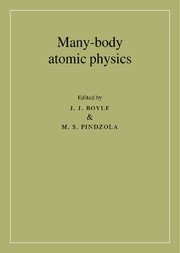Book contents
- Front Matter
- Contents
- Foreword
- Contributors
- Preface
- Acknowledgements
- Part 1 ATOMIC STRUCTURE
- Part 2 PHOTOIONIZATION OF ATOMS
- Part 3 ATOMIC SCATTERING: A. General Considerations
- Part 3 ATOMIC SCATTERING: B. Low-order applications
- Part 3 ATOMIC SCATTERING: C. All-order applications
- 13 R-matrix theory: some recent applications
- 14 Electron scattering from atomic targets: application of Dirac R-matrix theory
- 15 Electron-ion collisions using close-coupling and distorted-wave theory
- Appendix: Units and notation
- References
- Index
13 - R-matrix theory: some recent applications
Published online by Cambridge University Press: 22 September 2009
- Front Matter
- Contents
- Foreword
- Contributors
- Preface
- Acknowledgements
- Part 1 ATOMIC STRUCTURE
- Part 2 PHOTOIONIZATION OF ATOMS
- Part 3 ATOMIC SCATTERING: A. General Considerations
- Part 3 ATOMIC SCATTERING: B. Low-order applications
- Part 3 ATOMIC SCATTERING: C. All-order applications
- 13 R-matrix theory: some recent applications
- 14 Electron scattering from atomic targets: application of Dirac R-matrix theory
- 15 Electron-ion collisions using close-coupling and distorted-wave theory
- Appendix: Units and notation
- References
- Index
Summary
Introduction
The R-matrix theory was first introduced by Wigner and Wigner and Eisenbud to describe nuclear resonance reactions. This theory was subsequently developed and applied by many workers in nuclear physics, and comprehensive reviews have been written by Lane and Thomas, Breit, and Barrett et al.
In recent years, it has been increasingly realised that the R-matrix method can also be used as an ab initio approach to describe a broad range of atomic and molecular structure and collision processes. These include: electron–atom and –ion excitation and ionization processes, electron–molecule scattering, positron–atom and –molecule scattering, atomic and molecular photoionization processes, free–free transitions, atomic and molecular bound state energies and oscillator strengths, atomic polarizabilities, atom–molecule reactive scattering, dissociative attachment and recombination processes and atomic multiphoton processes. Reviews of the theory and applications to atomic and molecular processes have been written by Burke and Robb and Burke and Berrington.
The present chapter is organised as follows. In the next section the basic R-matrix theory of atomic and molecular processes is summarised. In the following section some recent applications of this basic theory are presented. Three examples are discussed: (i) low energy electron scattering by ions of Fe; (ii) electron scattering by atoms and ions at intermediate energies and (iii) multiphoton processes.
Basic theory
We summarise in this section R-matrix theory describing low energy electron impact excitation of light atoms and ions where relativistic effects can be neglected.
- Type
- Chapter
- Information
- Many-Body Atomic Physics , pp. 305 - 324Publisher: Cambridge University PressPrint publication year: 1998
- 3
- Cited by

